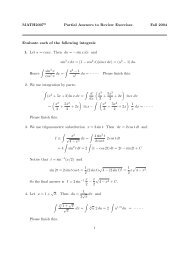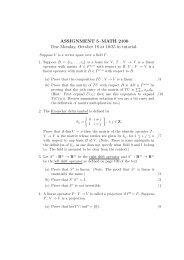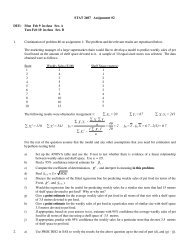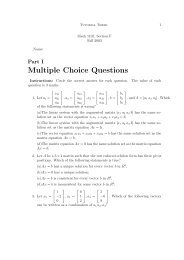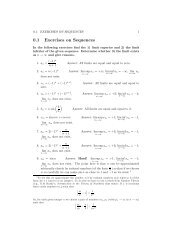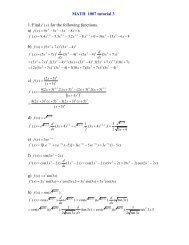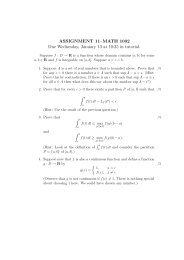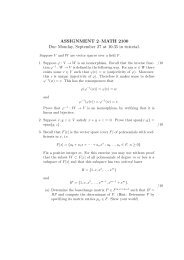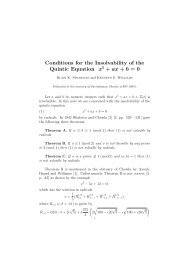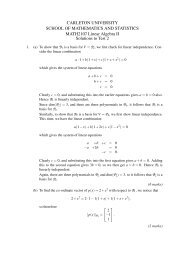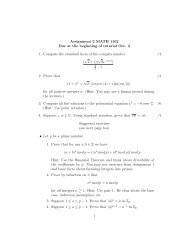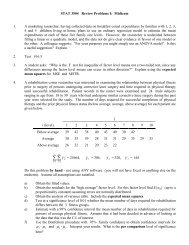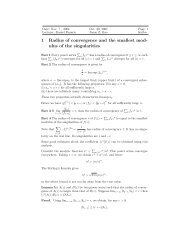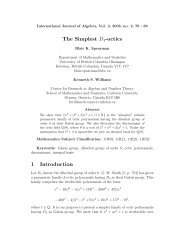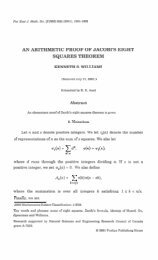Gennady Shaikhet – Teaching Statement - Department of ...
Gennady Shaikhet – Teaching Statement - Department of ...
Gennady Shaikhet – Teaching Statement - Department of ...
You also want an ePaper? Increase the reach of your titles
YUMPU automatically turns print PDFs into web optimized ePapers that Google loves.
<strong>Gennady</strong> <strong>Shaikhet</strong> <strong>–</strong> <strong>Teaching</strong> <strong>Statement</strong><br />
Work: 412-268-3781 shaikhet@cmu.edu www.math.cmu.edu/~shaikhet<br />
I feel capable <strong>of</strong> teaching courses from the basic mathematics/statistics/operations research<br />
curriculum, both on undergraduate and graduate level. I can also design various applied<br />
probability courses, in particular, with applications to optimization, queueing theory and<br />
finance.<br />
I have had three years <strong>of</strong> experience teaching undergraduate courses in the <strong>Department</strong><br />
<strong>of</strong> Mathematical Sciences at Carnegie Mellon University. During that time, I taught<br />
Simulation and Continuous Time Finance. The Simulation course was new to the<br />
department, and I had to design it. As for the Finance, pr<strong>of</strong>essor Steven Shreve has<br />
successfully taught the course on the graduate MBA level and I, with his book as a<br />
textbook, needed to adjust the level to undergraduate setting. I will teach these courses in<br />
the next academic year as well.<br />
My main teaching statement can be put this way: I am fascinated with mathematics,<br />
especially applied probability, and try to transfer my excitement to students. This, I<br />
believe, will motivate learning, since no one can teach a person, who does not want to<br />
learn. To succeed, one has to be a good lecturer - hard working, creative and careful <strong>–</strong><br />
because today’s students are smart and will not accept a fake.<br />
I think it worth describing how my personal experience has influenced my teaching. My<br />
undergraduate Math degree is from Donetsk State University, Ukraine (former Ukrainian<br />
Republic <strong>of</strong> USSR), and I may as well be considered as a product <strong>of</strong> Soviet system <strong>of</strong><br />
mathematical education. I have gotten a solid background, as well as a strong impression<br />
that the way we were taught things <strong>–</strong> lots <strong>of</strong> hard-core science without much intuition or<br />
examples <strong>–</strong> was not beneficial for the vast majority <strong>of</strong> my classmates. Students knew things,<br />
but did not understand them. They were simply not taught to do that.<br />
In 1999 I immigrated to Israel, and in 2000 was accepted to the Technion, to program in<br />
Statistics. In Technion, Statistics belongs to the <strong>Department</strong> <strong>of</strong> Industrial Engineering and<br />
Management and there I got my first ever teaching assistantship job. We taught probability<br />
theory to Engineering and Computer Science students. In Hebrew. This was quite the<br />
opposite <strong>of</strong> what I had in Ukraine. The students needed intuition, examples and computer<br />
demonstrations, which I was happy to provide to them. At that time, I used to build my<br />
recitations in a lecture form, with a reasonable part devoted to theory. Together with other<br />
assistants, we even wrote and distributed our own lecture notes, in which we usually<br />
included main concepts, demonstrated on nice examples. From that time on I have adopted
<strong>Teaching</strong> <strong>Statement</strong><br />
Page 2<br />
this way <strong>of</strong> lecturing <strong>–</strong> before proving/explaining some theorem, start from an interesting,<br />
non-trivial example, compute it and get what you need to get. Surprise the students! Then<br />
introduce the theorem. Once they saw how it worked, they would be more interested in the<br />
theorem and its pro<strong>of</strong>.<br />
An important step in my teaching occurred in 2004, when I started to be a TA to pr<strong>of</strong>essor<br />
Avishai Mandelbaum. The course was called Service Engineering, and was a mixture <strong>of</strong><br />
stochastic processes and various practical applications. From that moment, each recitation had<br />
to be prepared as a self-contained lecture, on slides. Often I had to teach a theory, not covered on<br />
lectures. Moreover, Avishai usually sat in on my recitations, sometimes commenting or<br />
correcting me, making notes about my teaching, and discussed them with me afterwards. To<br />
succeed I had to reassess my preparation and teaching. It has been a good school for me after<br />
all, and I felt confident going to teach at Carnegie Mellon as a Postdoc.<br />
It started smooth. The lecture, I thought, is much like a recitation, and worked on making<br />
perfect lectures. One day I suddenly realized that was not enough. In addition, I had to plan<br />
things, had to see the whole picture <strong>of</strong> where it goes to and what I want students to know.<br />
Especially, since I was designing a new course. Moreover, for many <strong>of</strong> students my lectures were<br />
the only source <strong>of</strong> material. That definitely required more responsibility, and took me some time<br />
to adapt. Now, after two years <strong>of</strong> teaching at Carnegie Mellon, I feel that my acclimation is<br />
successful and my passion to teaching has only grown.<br />
Wise man once told me that in academy one should always thrive to have fun on both fronts,<br />
research and teaching, and I was lucky to see live examples <strong>of</strong> people combining them on a<br />
highest level possible. Avishai Mandelbaum, Steven Shreve, Kavita Ramanan, Robert Adler are<br />
just a few with whom I was lucky to teach, work or study. My own experience so far has also<br />
been successful: usually I have been able to incorporate research papers/ideas in my teaching,<br />
whether in regular courses, or during summer projects with undergraduate students. First <strong>of</strong> all, I<br />
am much more passionate when I speak <strong>of</strong> what I do and love; second, students are really<br />
excited to see that they can apply their knowledge to solve some modern research questions.<br />
Luckily, applied probability gives us so many interesting examples. On the other hand, one can<br />
<strong>of</strong>ten benefit from teaching as well: there are always challenges in explaining some hard concept,<br />
or answering some interesting question in class. Dealing with such challenges enriches the<br />
background and even motivates some research directions.
Detailed list <strong>of</strong> my courses:<br />
• Monte Carlo Simulation (Fall 2007, 2008, 2009), Carnegie Mellon.<br />
<strong>Teaching</strong> <strong>Statement</strong><br />
Page 3<br />
I have designed and taught this course at the <strong>Department</strong> <strong>of</strong> Math. Sciences. The course is<br />
intended for undergraduates from Math and Engineering departments. Usually taken in the<br />
framework <strong>of</strong> “BSc in Computational Finance” program. The topics include main algorithms <strong>of</strong><br />
Monte Carlo; simulation <strong>of</strong> basic stochastic processes, in particular, Brownian motion and<br />
Poisson process; applications to financial engineering and queueing theory: derivatives pricing,<br />
performance analysis <strong>of</strong> queueing networks. As well as Markov Chain Monte Carlo methods:<br />
Metropolis-Hastings samplers, Gibbs sampling with applications to Ising model, simulated<br />
annealing, traveling salesman problem, etc.<br />
• Continuous <strong>–</strong> Time Finance (Spring 2008, 2009), Carnegie Mellon.<br />
The course is given in the framework <strong>of</strong> “BSc in Computational Finance” program at the<br />
<strong>Department</strong> <strong>of</strong> Math. Sciences. The topics include introduction to measure-theoretic<br />
probability, stochastic processes, Brownian motion, martingales, stochastic integration and<br />
Ito's lemma. The theory is then applied to derivation <strong>of</strong> the Black-Scholes formula and risk-<br />
neutral pricing <strong>of</strong> various financial derivatives.<br />
• Project director (Summer 2008, 2009), Carnegie Mellon.<br />
I have supervised students projects (three projects each year) in the framework <strong>of</strong> the Center<br />
for Nonlinear Analysis (CNA) Institute. The topics included applied probability, finance<br />
and simulation.<br />
• <strong>Teaching</strong> assistance (2000-2007), Technion, Israel.<br />
For the period <strong>of</strong> 2000 <strong>–</strong> 2007 I served as a teaching assistant at the Faculty <strong>of</strong> Industrial<br />
Engineering and Management, Technion. In 2003 I won the Excellent <strong>Teaching</strong> Assistant Prize.<br />
Some <strong>of</strong> the courses I taught:<br />
• Advanced Probability, in different times with Haya Kaspi or Robert Adler.<br />
• Stochastic Models, with Avishai Mandelbaum or Leonid Mytnik.<br />
• Stochastic Processes (graduate course), with Robert Adler.<br />
• Service Engineering, with Avishai Mandelbaum.<br />
Course website: http://iew3.technion.ac.il/serveng/



